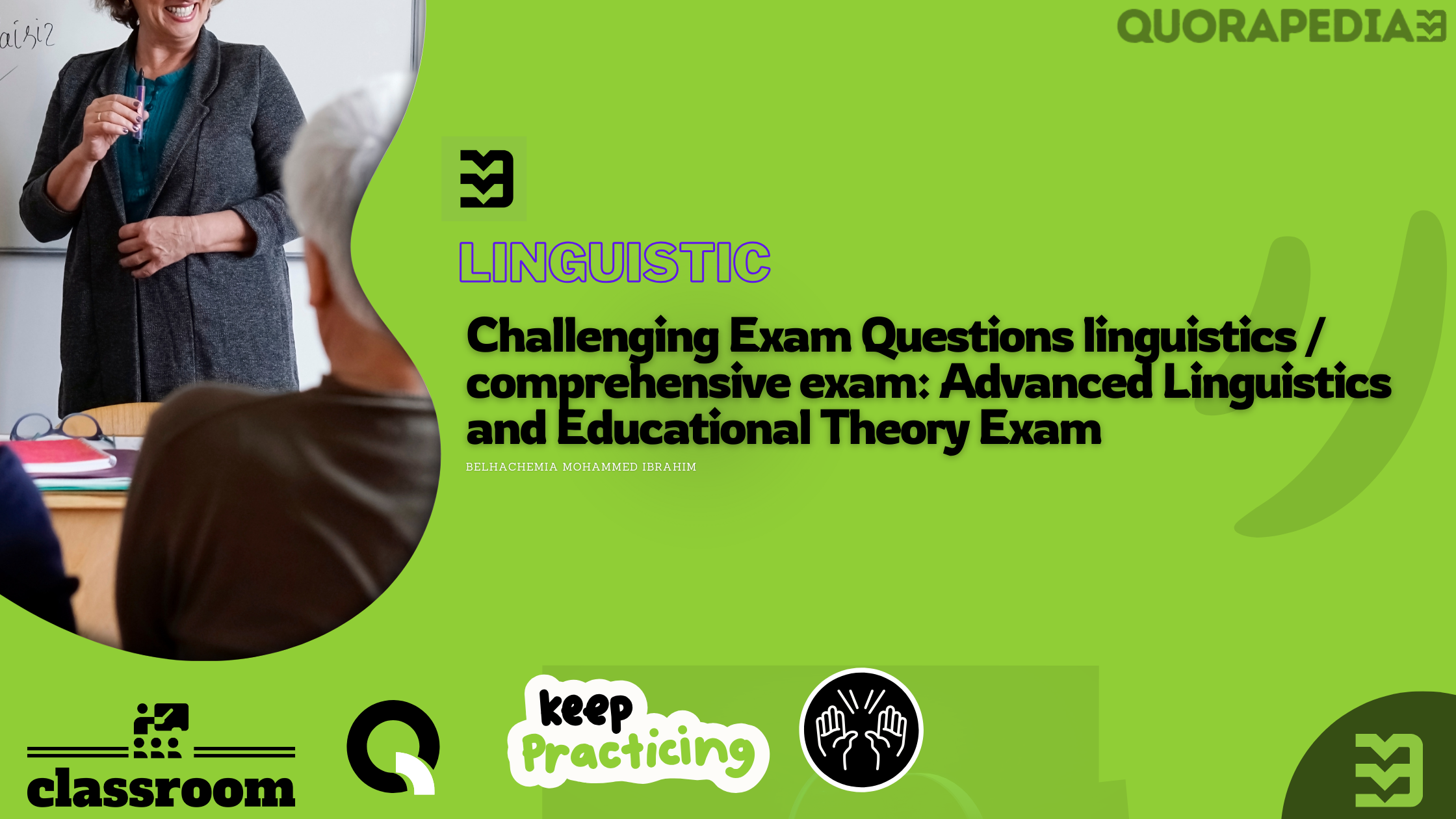
Check out

Challenging Exam Questions
Sequence 1: Structuralism
- Multiple Choice:
- Question: Which concept introduced by Ferdinand de Saussure emphasizes the arbitrary nature of the linguistic sign?
- A) Synchronic analysis
- B) Signifier and signified
- C) Langue and parole
- D) Phoneme
- Question: Which concept introduced by Ferdinand de Saussure emphasizes the arbitrary nature of the linguistic sign?
- Short Answer:
- Question: Discuss the implications of Saussure’s concept of the linguistic sign on semiotics.
- Essay:
- Question: Analyze the theoretical divergences between Ferdinand de Saussure and Leonard Bloomfield concerning the structure of language. Include specific examples from their theories.
Sequence 2: Functionalism
- True or False:
- Statement: Roman Jakobson's functional approach to language was primarily influenced by his work in phonology and phonetics.
- Short Answer:
- Question: Explain M.A.K. Halliday’s concept of the ideational metafunction and its relevance to understanding language in social contexts.
- Essay:
- Question: Critically assess the impact of functionalism on contemporary linguistics, focusing on the contributions of Roman Jakobson and M.A.K. Halliday.
Sequence 3: Comparative Analysis of Cognitivism and Constructivism
- Multiple Choice:
- Question: Which of the following is not a principle of Constructivism?
- A) Knowledge is actively constructed by the learner.
- B) Learning is a process of mental organization.
- C) Social interactions are crucial to cognitive development.
- D) Learning involves passive reception of information.
- Question: Which of the following is not a principle of Constructivism?
- Short Answer:
- Question: Compare the roles of the teacher in Cognitivist versus Constructivist learning environments.
- Essay:
- Question: Explore the influence of Lev Vygotsky's theories on modern educational practices, emphasizing his ideas on social learning and the Zone of Proximal Development.
Answer Key for Challenging Exam
Sequence 1: Structuralism
- Multiple Choice:
- Answer: B) Signifier and signified
- Short Answer:
- Answer: Saussure’s concept of the linguistic sign challenges the direct connection between words and their meanings, suggesting that meanings are established through differential relations within the language system itself. This foundational idea in semiotics shows how signs are interpreted through their relationships and contrasts with other signs.
- Essay:
- Answer: Students should highlight Saussure's focus on the structural aspects of language (e.g., his emphasis on the role of underlying structures over individual instances) versus Bloomfield's behaviorist leanings that language could be understood through observable behaviors and linguistic outputs. Key examples include Saussure's theoretical abstraction versus Bloomfield's empirical data focus.
Sequence 2: Functionalism
- True or False:
- Answer: False
- Short Answer:
- Answer: The ideational metafunction represents the use of language to express content and experience about the real world. It is crucial for understanding how language constructs reality, an essential aspect of analyzing language in social contexts as it reveals how individuals perceive and interact with their environment.
- Essay:
- Answer: Responses should evaluate how functionalism, through its focus on language functions and uses within real-life contexts, influences areas like discourse analysis and sociolinguistics. Contributions by Jakobson and Halliday, such as the communicative functions and metafunctions, should be discussed in terms of their practical applications in linguistic studies.
Sequence 3: Comparative Analysis of Cognitivism and Constructivism
- Multiple Choice:
- Answer: D) Learning involves passive reception of information
- Short Answer:
- Answer: In Cognitivism, the teacher's role is to structure content and facilitate the correct processing of information. In Constructivism, the teacher acts as a guide or facilitator, helping students build their understanding through active exploration and interaction.
- Essay:
- Answer: The essay should detail Vygotsky's contribution to the understanding of learning as a social activity, with emphasis on the ZPD and the role of more knowledgeable others. Examples should include applications in collaborative learning, scaffolding techniques, and the emphasis on language in cognitive development.
Advanced Exam Questions
Sequence 1: Structuralism
- Diagram Interpretation:
- Question: Refer to the provided diagram illustrating Saussure's model of the linguistic sign. Identify the elements labeled "A" (the concept) and "B" (the sound-image), and explain their relationship.
- Fill-in-the-Blank:
- Question: "The relationship between ________ and ________ is central to understanding Saussure's theory of structural linguistics."
- Case Study Analysis:
- Question: Analyze a brief text provided in the exam, using Saussure's principles of langue and parole. Identify elements of the structure that reflect these concepts.
Sequence 2: Functionalism
- True or False:
- Statement: Functionalism argues that language forms evolve primarily based on their utility in social contexts.
- Diagram Interpretation:
- Question: Examine the chart depicting Halliday's three metafunctions of language. Describe how the ideational metafunction is used in the example provided.
- Case Study Analysis:
- Question: Given a transcript of a conversation, apply Jakobson's six functions of language to analyze the communicative purpose behind each statement.
Sequence 3: Comparative Analysis of Cognitivism and Constructivism
- True or False:
- Statement: Constructivism dismisses the role of previous knowledge in learning processes.
- Fill-in-the-Blank:
- Question: "According to Vygotsky, the __________ is the difference between what a learner can do without help and what he or she can do with help."
- Case Study Analysis:
- Question: You are presented with a scenario in which a teacher uses a series of educational strategies. Identify whether these strategies are more aligned with Cognitivism or Constructivism, and justify your choice based on the theories.
Answer Key
Sequence 1: Structuralism
- Diagram Interpretation:
- Answer: A is the 'signified' (concept) and B is the 'signifier' (sound-image). Their relationship is arbitrary and foundational in Saussure's model, where the signifier represents the sound-image associated with the signified concept without any inherent connection to its meaning.
- Fill-in-the-Blank:
- Answer: "The relationship between signifier and signified is central to understanding Saussure's theory of structural linguistics."
- Case Study Analysis:
- Answer: Students should identify specific use of vocabulary, sentence structures, and expressions that demonstrate the application of langue (systematic elements of language known by a community) and parole (specific speech acts by an individual).
Sequence 2: Functionalism
- True or False:
- Answer: True
- Diagram Interpretation:
- Answer: The ideational metafunction is demonstrated in the example through its use in representing reality and sharing experiences. It helps to link the linguistic choices to their functions in constructing meaningful expressions about the world.
- Case Study Analysis:
- Answer: The analysis should reflect how each function (emotive, conative, referential, phatic, metalinguistic, poetic) is manifested in the conversation, identifying elements like emotion expression, commands, information sharing, social interaction, language discussion, and aesthetic choice.
Sequence 3: Comparative Analysis of Cognitivism and Constructivism
- True or False:
- Answer: False
- Fill-in-the-Blank:
- Answer: "According to Vygotsky, the Zone of Proximal Development is the difference between what a learner can do without help and what he or she can do with help."
- Case Study Analysis:
- Answer: Answers should detail specific strategies (e.g., problem-solving tasks, guided discovery) and align them with either the cognitivist emphasis on structured learning processes and cognitive operations or the constructivist focus on active, contextual learning through social interaction and experience.
Advanced Exam Questions
Sequence 1: Structuralism
- Matching:
- Question: Match the following terms with their correct definitions:
- A) Langue
- B) Parole
- C) Synchronic
- D) Diachronic
- Definitions:
- Question: Match the following terms with their correct definitions:
1. Study of a language over a period of time.
2. Speech acts or utterances of an individual.
3. Language as a system shared by a community.
4. Study of a language at a particular point in time.
- Scenario-Based Question:
- Question: Imagine a linguist analyzing a newly discovered language that lacks documentation. Using Structuralism principles, outline the steps they would take to study this language.
- Critical Thinking:
- Question: Discuss how Structuralism might limit our understanding of language evolution. Provide examples to support your argument.
Sequence 2: Functionalism
- Matching:
- Question: Match each language function identified by Roman Jakobson with its corresponding linguistic feature:
- A) Emotive
- B) Conative
- C) Referential
- D) Phatic
- Features:
-
- Commands and requests
-
- Question: Match each language function identified by Roman Jakobson with its corresponding linguistic feature:
- Expression of feelings and attitudes
- Establishing and maintaining communication
- Relaying factual information
- Scenario-Based Question:
- Question: A teacher uses different language functions during a classroom session. Describe how Functionalism would explain the teacher’s choice of language functions to manage the classroom.
- Critical Thinking:
- Question: Evaluate the implications of M.A.K. Halliday's Systemic Functional Linguistics in modern discourse analysis. What are its strengths and limitations?
Sequence 3: Comparative Analysis of Cognitivism and Constructivism
- Matching:
- Question: Match the following learning concepts with the theory they are most associated with:
- A) Active mental reconstruction
- B) Information processing
- C) Social interaction
- D) Structured learning environment
- Theories:
- Constructivism
- Cognitivism
- Question: Match the following learning concepts with the theory they are most associated with:
- Scenario-Based Question:
- Question: Consider a student struggling to solve a math problem. Describe how a teacher following Constructivist principles would assist the student differently from a teacher following Cognitivist principles.
- Critical Thinking:
- Question: Critique the role of technology in learning environments from the perspectives of Cognitivism and Constructivism. Discuss potential benefits and drawbacks according to each theory.
Comprehensive Exam Questions
Sequence 1: Structuralism
- Essay:
- Question: Critically evaluate the impact of Ferdinand de Saussure's theory of Structuralism on contemporary linguistic studies. Discuss its relevance and any limitations it may pose in the study of evolving languages.
- Comparative Analysis:
- Question: Compare and contrast the views of Ferdinand de Saussure and Leonard Bloomfield on the structural aspects of language. How do their perspectives differ in terms of methodology and application?
- Practical Application:
- Question: Given a sample of text (provided in the exam), apply Saussure's concepts of 'signifier' and 'signified' to analyze the text's structure and meaning.
Sequence 2: Functionalism
- Essay:
- Question: Analyze how M.A.K. Halliday's Systemic Functional Linguistics has contributed to understanding the social functions of language. Illustrate your essay with examples from specific linguistic studies.
- Comparative Analysis:
- Question: Discuss the similarities and differences between the functionalist views of language as proposed by Roman Jakobson and M.A.K. Halliday. Focus on their approaches to the functions of language in communication.
- Practical Application:
- Question: Analyze a recorded political speech (transcript provided in the exam) using Halliday's three metafunctions of language: ideational, interpersonal, and textual.
Sequence 3: Comparative Analysis of Cognitivism and Constructivism
- Essay:
- Question: Evaluate the influence of Lev Vygotsky's theories on modern educational practices. How do his ideas support or challenge the traditional views of learning and development?
- Comparative Analysis:
- Question: Contrast the approaches of Cognitivism and Constructivism in dealing with learning disabilities. Which theory provides a more effective framework for supporting students with learning challenges?
- Practical Application:
- Question: Design a learning activity for a high school history class that incorporates both Cognitivist and Constructivist principles. Describe the activity and explain how it aligns with each educational theory.
Answer Key
Sequence 1: Structuralism
- Essay:
- Answer: Ferdinand de Saussure's Structuralism laid the foundation for modern linguistic and semiotic studies. It introduced the concept of language as a system of interrelated elements, where each element's meaning is derived not from inherent characteristics but from its function and relation to other elements. This theory has heavily influenced the development of later linguistic theories, such as post-structuralism and social constructivism. Limitations include its focus on the synchronic analysis of language, which overlooks the historical development (diachronic aspects) and its potential inability to address the dynamic nature of spoken languages and dialects.
- Comparative Analysis:
- Answer: Ferdinand de Saussure focused on the abstract structural aspects of language, emphasizing the importance of underlying structures over observable linguistic phenomena, which he considered manifestations of these deeper systems. Leonard Bloomfield, however, was more empirical and behaviorist, emphasizing the collection and analysis of linguistic data over theoretical speculation. Saussure's approach is more theoretical, prioritizing the langue (language system) over parole (speech acts), whereas Bloomfield’s approach is more practical and grounded in observable linguistic behavior.
- Practical Application:
- Answer: In applying Saussure's concepts to a sample text, one would identify signifiers (words, phrases) and their signified concepts (meanings). For instance, the word "tree" is a signifier, and the mental image or concept of a tree is the signified. Analysis would involve breaking down the text to show how each signifier relates to its signified and how these pairings interact within the larger structure of the text to produce meaning.
Sequence 2: Functionalism
- Essay:
- Answer: M.A.K. Halliday’s Systemic Functional Linguistics (SFL) views language as a social resource, emphasizing how individuals use language to perform social functions. This approach has significantly influenced the fields of discourse analysis, educational linguistics, and sociolinguistics by providing tools to analyze how language constructs social identities and power dynamics. Examples include studies on classroom discourse and the language of media, illustrating how language choices shape and are shaped by social contexts.
- Comparative Analysis:
- Answer: Both Roman Jakobson and M.A.K. Halliday view language as serving multiple functions but conceptualize these functions differently. Jakobson identifies six communication functions that are more focused on the form and immediate context of speech, such as emotive or conative functions. Halliday proposes three broader metafunctions that are inherently social and consider broader contextual influences on language use, such as the ideational and interpersonal functions.
- Practical Application:
- Answer: In analyzing a political speech using Halliday's metafunctions, one would note how the speaker uses the ideational function to represent events or situations (e.g., describing political achievements), the interpersonal function to engage with the audience (e.g., using inclusive language like "we" or "our"), and the textual function to organize the speech coherently (e.g., using connectors and thematic structures to link ideas).
Sequence 3: Comparative Analysis of Cognitivism and Constructivism
- Essay:
- Answer: Lev Vygotsky's theories, especially his concepts of the Zone of Proximal Development (ZPD) and social learning, have significantly influenced modern educational practices by emphasizing the importance of social interaction and scaffolding in learning. His ideas challenge traditional teacher-centered methods, promoting a more collaborative and interactive classroom environment where students play an active role in their learning.
- Comparative Analysis:
- Answer: Cognitivism focuses on the mental processes involved in learning, suggesting structured approaches to address learning disabilities, such as specific interventions targeting memory or processing skills. Constructivism, on the other hand, emphasizes learning through experience and social interaction, advocating for adaptive learning environments that are responsive to individual learner’s needs and contexts, potentially offering a more flexible and holistic approach to learning disabilities.
- Practical Application:
- Answer: A high school history class activity could involve students working in groups to research different historical events (Constructivist approach) and then individually processing the information to identify causes and effects (Cognitivist approach). The activity could culminate in a class discussion where each group presents their findings, facilitating peer learning and teacher-led clarification, effectively integrating both educational theories.






